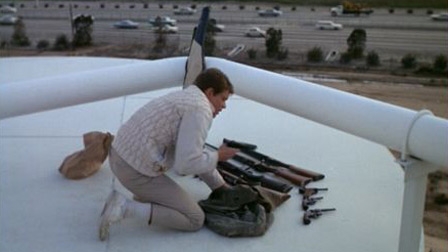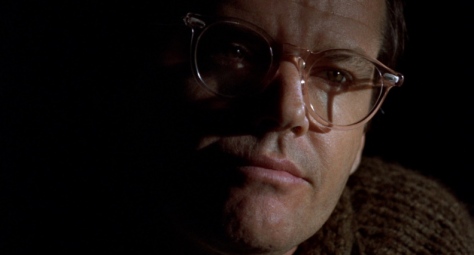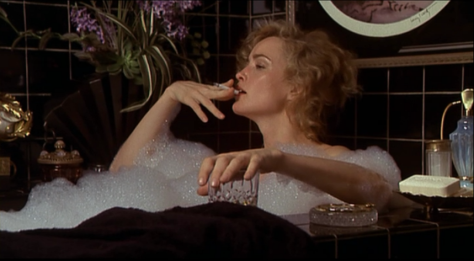By Dennis Hartley
(Originally posted on Digby’s Hullabaloo on January 17, 2009)

Ricardo Montalban was well known as a TV actor (Fantasy Island) and as the Chrysler Cordoba’s pitch man, but also had a number of film credits during his 66 year career. He never snagged an Oscar, but did earn an Emmy and a Screen Actor’s Guild Lifetime Achievement Award in 1993.
He may not have been a critic’s darling, and was a frequent target of ridicule for late-night TV comics (which sometimes smacked uncomfortably of “unconscious” racism to me, like Billy Crystal’s Fernando Lamas shtick) but he always remained a classy, dependable performer with a powerful physical presence and charisma that served him well throughout his career.
A Mexico City native, he immigrated to the U.S. in the early 1940s and made a name for himself in radio, theatre, film and TV, helping break down barriers along the way. He founded a non-profit organization (the Nosotros Foundation) dedicated to helping dismantle character stereotypes and to push open more doors for Hispanic performers. Vaya con dios, Don Ricardo.
Recommended viewing:
Border Incident-A typically taut and tough little noir from the underrated Anthony Mann features an excellent performance from Montalban as a Mexican police officer who goes undercover to help U.S. immigration officials bust an exploitative human smuggling ring.
Mystery Street-This is another early 50s noir with Montalban, this time as a Boston police lieutenant investigating the murder of a young woman whose bones are found on a beach. This was one of the first police procedural dramas to showcase forensic science.
Sayonara-This uneven 1957 culture clash drama (based on the James Michener novel) was primarily a vehicle for star Marlon Brando and has not dated very well, but Montalban had a memorable (if a bit oddly cast) role as a Japanese character. Go figure.
Escape from the Planet of the Apes-Although this franchise became sillier with each installment, this entry has its moments, including a likeable performance by Montalban as the kindly carny who adopts the baby chimp who grows up to become…oh, never mind.
Star Trek II: The Wrath of Khan-“Khaaaaahnn!!” Montalban’s turn as the charismatic leader of a renegade group of genetically tweaked supermen not only presented Shatner’s Captain Kirk with a formidable nemesis, but an equally hammy acting partner as well.

Alas, more sad news to report. No. 6 has also left The Island. Patrick McGoohan, like Ricardo Montalban, had an eclectic career as an actor (theater, film and TV) but will be best remembered for his work on the small screen. The brooding Irish actor (actually born in Astoria, N.Y., oddly enough) became synonymous with two memorable British TV characters in the 1960s: John Drake (in Danger Man, aka Secret Agent Man on this side of the pond) and the enigmatic “No. 6” in the short-lived summer replacement series which has become a long-running cult phenom, The Prisoner.
Now, there are some who may go to great lengths to convince you that “John Drake” and “No. 6” are one and the same person…but I’m not going to open that can of worms (I may have already done so). I admit to owning the series on DVD, but I can’t tell you with 100% confidence that I’ve got it all sussed, despite repeated viewings over the years (even McGoohan took its cryptic subtexts with him…erm, to his grave). Maybe that was his point? Be seeing you!
Recommended viewing:
All Night Long-This rarely screened curio is (literally) a jazzed-up retooling of Othello, with McGoohan starring as a conniving musician (he’s not half-bad on the drums). Cameos by Dave Brubeck, Charlies Mingus and other jazz stars lend the film some hip factor.
Ice Station Zebra-This all-star Cold War thriller is still best appreciated in its original Cinerama format. McGoohan plays (surprise) an enigmatic heavy (or is he?). Directed by John Sturges (who also helmed Mystery Street, on my Montalban list above).
Silver Streak-Director Arthur Hiller and screenwriter Colin Higgins teamed up for this Hitchcock homage that takes place on a train. Gene Wilder, Jill Clayburgh and Richard Pryor steal the show, but McGoohan is “on board” as The Heavy (again). Choo-choo!
Scanners-This early effort from the twisted David Cronenberg is not his best, but as far as movies with exploding noggins go, it’s a ”head” above the rest. Performances range from bad to wooden (McGoohan is the only real actor in the cast) but it’s still a cult fave.
Braveheart-We’re gonna party like it’s 1299! Mel Gibson’s testosterone ‘n’ kilts fest (file under: “Sort of” Historical Epic) featured one of McGoohan’s better latter-day film performances as Edward Longshanks-the king everyone loved to hate “back in the day”.
And I can’t think of a more fitting tribute to Mr. McGoohan than this music video gem from one of my favorite 1980s British power-pop outfits, The Times:

























